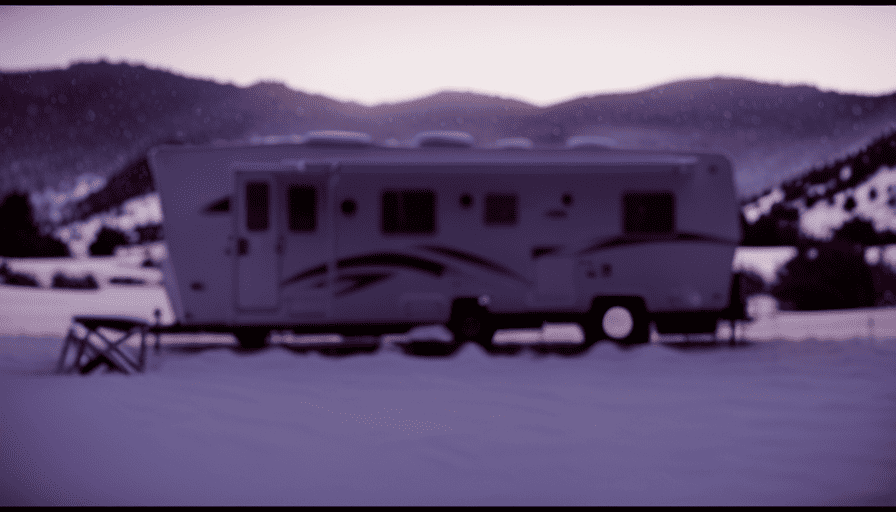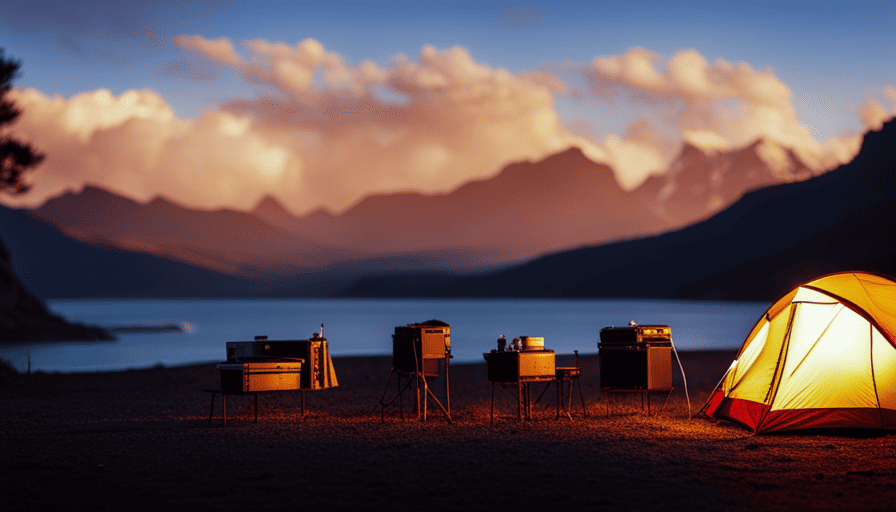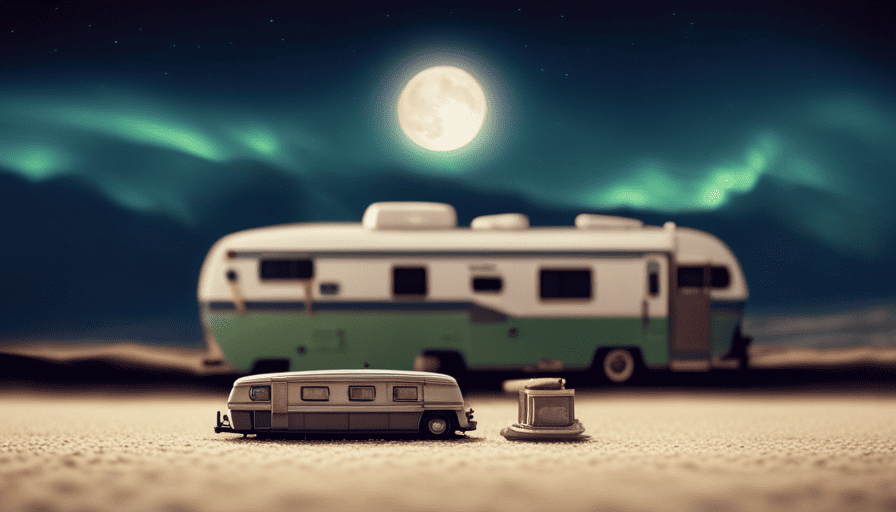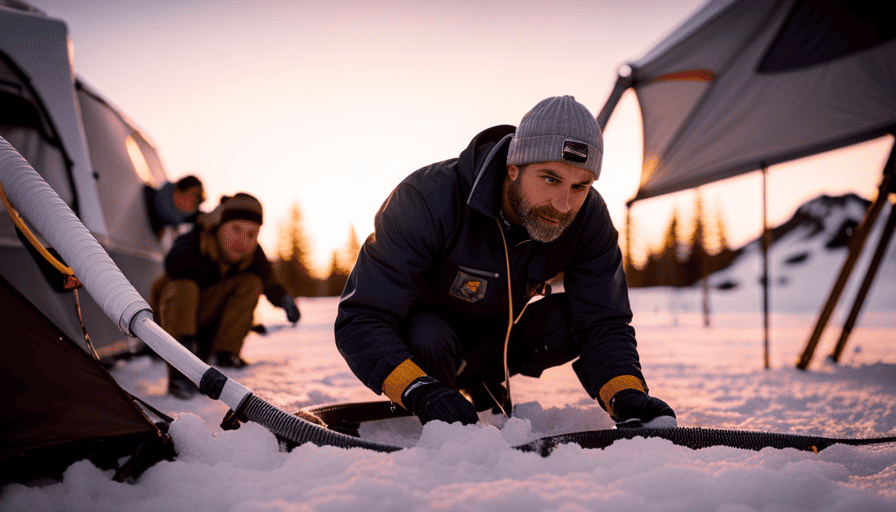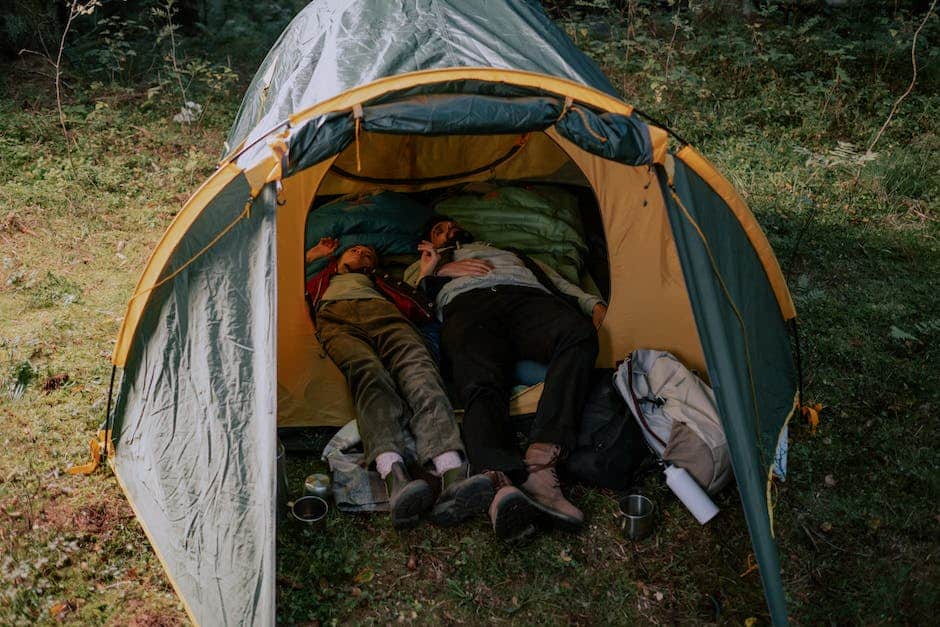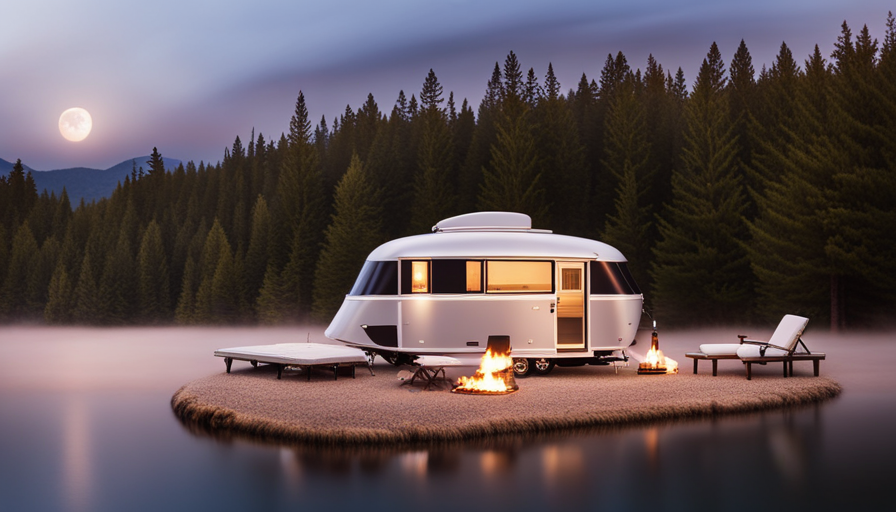Were you aware that there are more than 11 million households in the United States with an RV? It’s an astonishing figure, representing numerous individuals taking to the highways to discover the vast expanse of nature.
But as the temperatures start to drop and winter sets in, it’s time to start thinking about how to protect your beloved camper from the harsh elements. In this article, I will share my knowledge and experience on how to properly winterize your camper, ensuring that it stays in top condition and is ready for your next adventure.
From gathering the necessary supplies to performing regular maintenance checks, I will guide you step by step through the process.
So grab a cup of hot cocoa, sit back, and let’s dive into the world of winterizing your camper.
Key Takeaways
- Winterizing your camper is essential for protecting it from harsh elements and ensuring its longevity.
- Steps for winterizing include draining and flushing the water system, emptying and cleaning holding tanks, insulating and sealing windows and doors, and protecting exterior surfaces.
- Regular maintenance checks and cleaning of the interior are important for preventing issues and maintaining a comfortable camping experience.
- Finding a dry and secure location to store the camper during winter, performing regular maintenance checks, and staying organized with checklists and storage solutions are crucial for a successful winter camping trip.
Gather the Necessary Supplies
To winterize your camper, you’ll need to gather all the necessary supplies. Winterizing supplies are essential to protect your camper from the harsh winter weather and prevent any damage.
Firstly, you’ll need antifreeze to protect the water system. Make sure to get the non-toxic kind, as it’s safe for drinking water systems. You’ll also need a water heater bypass kit to prevent antifreeze from filling up the water heater.
Additionally, you’ll need a compressor or an air pump to blow out any remaining water from the pipes. Don’t forget to get a cover to protect your camper from snow, ice, and other elements.
In addition to the winterizing supplies, there are a few tips for storing the camper during the winter months. It’s important to clean the camper thoroughly before storing it to prevent any mold or mildew growth. Remove all food items and perishables to avoid attracting pests. It’s also a good idea to remove the batteries and store them separately to prevent them from freezing. Lastly, make sure to secure the camper in a safe and dry location.
Now that you’ve gathered all the necessary supplies and have some tips for storing the camper, it’s time to move on to the next step: draining and flushing the water system.
Drain and Flush the Water System
First, make sure to drain and flush the water system in your camper to prepare it for winter. This is a crucial step in the winterizing process as it helps prevent freezing and potential damage to your camper. Here’s a step-by-step guide on how to properly drain and flush the water system:
-
Start by turning off the water supply to your camper and opening all faucets, including the showerhead and outdoor shower, to release any remaining water.
-
Locate the drain valves for both the fresh water and hot water tanks. Open these valves to allow any water to drain out completely.
-
Once the tanks are drained, close the drain valves and use compressed air to blow out any remaining water from the lines. Connect the air compressor to the city water inlet and slowly introduce air into the system.
-
Go back inside the camper and open each faucet one by one to allow the air to push out any remaining water.
By following these winterizing steps, you can ensure that your camper’s water system is properly prepared for the cold winter months.
Next, we’ll discuss how to empty and clean the holding tanks, another important aspect of winterizing your camper.
Empty and Clean the Holding Tanks
Now, it’s time to tackle the task of emptying and cleaning the holding tanks in your camper. Holding tank maintenance is an essential part of winterizing your camper and ensuring its longevity.
To begin, locate the valves for the black and gray water tanks. Open them one at a time, starting with the black water tank, and allow the contents to drain completely into a designated waste disposal area.
Once the tanks are emptied, it’s crucial to flush them thoroughly to remove any remaining waste or residue. This can be done by using a tank flush system, which uses pressurized water to clean the tanks. Alternatively, you can use a specialized tank cleaning wand.
After the tanks have been emptied and flushed, it’s time to move on to the next step of the winterizing checklist: insulating and sealing windows and doors. By properly insulating and sealing these areas, you can prevent cold drafts from entering your camper and keep it warm and cozy during the winter months.
Insulate and Seal Windows and Doors
Once the tanks have been emptied and thoroughly flushed, it’s important to enhance the insulation and seal around the windows and doors in order to create a warm and cozy environment inside.
Proper window insulation is crucial to keep the cold air out and retain heat inside the camper. I recommend using window insulation film, which is easy to install and provides an extra layer of insulation. Simply measure the windows, cut the film accordingly, and apply it using double-sided tape. This will create an airtight seal, preventing drafts and reducing heat loss.
Next, focus on sealing the doors to prevent any gaps that could let cold air in. Check the weatherstripping around the doors and replace it if necessary. Additionally, you can use draft stoppers or door sweeps to further enhance the seal. These can be easily attached to the bottom of the door, effectively blocking any gaps and keeping the heat inside.
By insulating the windows and sealing the doors, you’ll significantly improve the camper’s ability to retain heat and create a cozy interior.
Now, let’s move on to the next step, which involves protecting the exterior surfaces of the camper.
Protect Exterior Surfaces
To ensure your camper is well-prepared for the winter season, take the time to protect its exterior surfaces from the harsh elements. This step is crucial in preventing damage and prolonging the life of your camper. Here are some effective ways to protect the exterior surfaces:
-
Use protective covers: Invest in high-quality covers that are designed specifically for your camper model. These covers will shield your camper from snow, ice, and other winter debris, preventing scratches and dings.
-
Seal cracks and crevices: Inspect the exterior of your camper for any cracks or gaps. Use weatherproof sealant to seal these areas, preventing moisture from seeping in and causing damage.
-
Rust prevention: Apply a rust inhibitor to any exposed metal surfaces on your camper. This will help protect against rust and corrosion caused by snow, ice, and road salt.
By taking these steps to protect the exterior surfaces of your camper, you can ensure that it remains in top condition throughout the winter months. After all, a well-protected exterior is essential for overall camper maintenance.
In the next section, we’ll discuss how to check and maintain the heating system.
Check and Maintain the Heating System
Maintaining a well-functioning heating system is crucial for a cozy and comfortable winter camping experience. Did you know that a survey found that 90% of campers consider a functioning heating system to be essential during the colder months? To ensure your heating system is ready for the winter, it is important to perform regular maintenance and troubleshoot any heating issues that may arise.
Here is a helpful table outlining some basic heating system maintenance tasks:
| Task | Frequency | Importance |
|---|---|---|
| Clean or replace air filters | Monthly | Very important |
| Inspect and clean vents | Annually | Important |
| Check for leaks or loose connections | Annually | Important |
| Lubricate moving parts | Annually | Important |
| Test thermostat | Before winter | Very important |
By following these maintenance tasks, you can ensure that your heating system is running efficiently and effectively throughout the winter camping season.
After checking and maintaining your heating system, the next step is to remove perishable items and clean the interior. This will help prevent any unwanted odors or pests and ensure a fresh start for your next camping adventure.
Remove Perishable Items and Clean the Interior
After ensuring the proper functionality of your heating system, it’s vital to remove any perishable items and thoroughly clean the interior to avoid unpleasant odors or pests. Cleaning the interior of your camper is an important step in winterizing and maintaining its condition during the off-season. Here are some cleaning tips and storage solutions to help you get started:
-
Start by removing all perishable items such as food, beverages, and toiletries. These items can spoil and attract insects or rodents if left behind.
-
Vacuum the floors, upholstery, and curtains to remove any dirt or debris. Pay special attention to hard-to-reach areas like corners and under furniture.
-
Wipe down all surfaces with a mild cleaner to remove any grease or stains. Don’t forget to clean the kitchen area, bathroom, and any other high-traffic areas.
-
Use a disinfectant spray to kill any bacteria or germs that may have accumulated.
-
Consider using storage solutions such as plastic bins or organizers to keep your belongings organized and protected from dust or moisture.
By following these cleaning tips and utilizing storage solutions, you can ensure that your camper stays clean and fresh during the winter months.
Now, it’s time to move on to the next step: storing the camper in a dry and secure location.
Store the Camper in a Dry and Secure Location
Finding a dry and secure location to store your camper will give you peace of mind and protect your investment from the harsh winter elements. There are several options for storing your camper during the winter months.
One popular option is to rent a storage unit specifically designed for RVs and campers. These units are typically climate-controlled and provide added security measures to keep your camper safe.
Another option is to store your camper in a covered storage facility or a barn. This will protect it from the snow and ice while still providing some level of shelter.
If neither of these options is available, you can also store your camper in your driveway or backyard. However, be sure to cover it with a waterproof tarp and take steps to prevent moisture buildup. This can be done by placing moisture-absorbing packets inside the camper and using a dehumidifier if necessary.
By storing your camper in a dry and secure location, you can prevent moisture damage and ensure that it is in good condition when you’re ready to use it again in the spring. Performing regular maintenance checks will also help to keep your camper in top shape during the winter months.
Perform Regular Maintenance Checks
To keep your camper in top shape during the winter months, it’s essential that you regularly check for any signs of wear and tear using the idiom ‘nip it in the bud’ before they turn into bigger problems.
Performing regular maintenance checks on your camper is crucial for winterizing it effectively. By inspecting all the components, you can identify any issues and address them promptly.
Start by examining the exterior for cracks, leaks, or damage to the roof, windows, and doors. Check the tires for proper inflation and look for signs of dry rot or wear.
Inside the camper, inspect the plumbing system, including the water heater and pipes, for any leaks or damage. Test the electrical system, ensuring all lights, appliances, and outlets are functioning correctly. Don’t forget to inspect the propane system for leaks and perform any necessary maintenance.
Regular maintenance checks are important for winterizing your camper because they allow you to catch and fix any potential problems before they worsen, ensuring your camper is ready for your next adventure. With proper maintenance, you can enjoy worry-free travels when the warmer months arrive.
Prepare for Your Next Adventure
Get ready for your next adventure by making sure your camper is fully prepared. One of the most important things you can do to ensure a successful trip is to stay organized.
Here are some tips for staying organized on your camping trips. First, create a checklist of all the items you need to bring and check them off as you pack. This will help you avoid forgetting anything important. Additionally, invest in storage solutions such as bins and hanging organizers to keep your belongings tidy and easily accessible. Another helpful tip is to label everything, from food containers to gear, so you can quickly find what you need.
In addition to staying organized, finding the best camping spots for your next adventure is crucial. Before setting off, do some research on campgrounds in your desired area. Look for reviews, amenities, and nearby attractions to ensure you choose the perfect spot. It’s also a good idea to book your campsite in advance, especially during peak seasons. This will guarantee you have a spot and save you from the stress of trying to find a place to stay at the last minute.
By following these tips, you’ll be well-prepared and ready to embark on your next camping adventure.
Frequently Asked Questions
How do I properly winterize the propane system in my camper?
To properly winterize the propane system in my camper, I take certain precautions for winter storage. First, I turn off the propane supply and shut off all appliances.
Then, I disconnect the propane tank and store it in a well-ventilated area. I also make sure to drain any remaining propane from the system.
Finally, I cover all propane lines and fittings with insulation to protect them from freezing temperatures. Following these steps ensures proper propane system maintenance during the winter months.
What should I do with the battery during winter storage?
During winter storage, it’s important to take proper care of the battery in your camper. To ensure its longevity, I recommend removing the battery and storing it in a cool, dry place.
Before storing, make sure to clean the battery terminals and apply a protective coating. This will help prevent corrosion and extend the battery’s life.
Additionally, consider disconnecting any appliances and protecting the camper’s exterior with a quality cover to prevent damage from the harsh winter elements.
Can I use antifreeze to winterize my camper’s plumbing system?
When it comes to winterizing a camper’s plumbing system, using antifreeze can be a practical option. The symbolism behind antifreeze is its ability to protect and preserve the plumbing system during freezing temperatures. The pros of using antifreeze include its effectiveness in preventing water from freezing and causing damage.
However, there are alternative methods available such as blowing out the water lines with compressed air. It’s important to weigh the pros and cons before deciding on the best method for your camper.
How often should I check the tire pressure during winter storage?
During winter storage, it’s crucial to regularly check the tire pressure to ensure optimal performance and prevent any potential damage. Fluctuating temperatures can cause the pressure to decrease, leading to flat spots or even tire failure.
I recommend checking the tire pressure at least once a month and before taking your camper out of storage. This simple maintenance tip will help extend the lifespan of your tires and keep you safe on the road.
Are there any specific steps I need to take to protect the camper’s awning during winterization?
Protecting the camper’s awning during winterization is crucial to ensure its longevity. But, what steps can you take to safeguard it?
Start by thoroughly cleaning the awning, removing any dirt or debris.
Next, retract and secure it properly to prevent damage from strong winds or heavy snow.
Consider using an awning cover or wrapping it with a tarp for added protection.
Regularly inspect and tighten any loose components.
By taking these precautions, you can safeguard your awning and enjoy worry-free winter storage.
What Are the Essential Steps to Winterize a Camper Trailer?
Winterizing your camper trailer is crucial to protecting it from harsh weather conditions. The essential steps include draining water systems, adding antifreeze, and insulating pipes. Additionally, sealing any cracks or openings, covering the exterior, and storing it properly are key. By following these steps, you can ensure your camper trailer remains in optimal condition during the winter season.
Conclusion
Well folks, that’s a wrap on winterizing your camper! It may seem like a daunting task, but with the right supplies and a little know-how, you can protect your beloved home on wheels from the harsh winter elements.
Remember to drain and flush the water system, empty and clean the holding tanks, and insulate and seal windows and doors. Don’t forget to protect the exterior surfaces and remove any perishable items from the interior.
Store your camper in a dry and secure location, and perform regular maintenance checks to ensure it’s ready for your next adventure. Happy trails!

